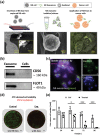On-Chip Biogenesis of Circulating NK Cell-Derived Exosomes in Non-Small Cell Lung Cancer Exhibits Antitumoral Activity
- PMID: 33747745
- PMCID: PMC7967048
- DOI: 10.1002/advs.202003747
On-Chip Biogenesis of Circulating NK Cell-Derived Exosomes in Non-Small Cell Lung Cancer Exhibits Antitumoral Activity
Abstract
As the recognition between natural killer (NK) cells and cancer cells does not require antigen presentation, NK cells are being actively studied for use in adoptive cell therapies in the rapidly evolving armamentarium of cancer immunotherapy. In addition to utilizing NK cells, recent studies have shown that exosomes derived from NK cells also exhibit antitumor properties. Furthermore, these NK cell-derived exosomes exhibit higher stability, greater modification potentials and less immunogenicity compared to NK cells. Therefore, technologies that allow highly sensitive and specific isolation of NK cells and NK cell-derived exosomes can enable personalized NK-mediated cancer therapeutics in the future. Here, a novel microfluidic system to collect patient-specific NK cells and on-chip biogenesis of NK-exosomes is proposed. In a small cohort of non-small cell lung cancer (NSCLC) patients, both NK cells and circulating tumor cells (CTCs) were isolated, and it is found NSCLC patients have high numbers of NK and NK-exosomes compared with healthy donors, and these concentrations show a trend of positive and negative correlations with bloodborne CTC numbers, respectively. It is further demonstrated that the NK-exosomes harvested from NK-graphene oxide chip exhibit cytotoxic effect on CTCs. This versatile system is expected to be used for patient-specific NK-based immunotherapies along with CTCs for potential prognostic/diagnostic applications.
Keywords: cancer immunotherapy; circulating tumor cells; exosome biogenesis; microfluidics; natural killer cells.
© 2021 The Authors. Advanced Science published by Wiley‐VCH GmbH.
Conflict of interest statement
S.N. is one of the named inventors on a patent for Microfluidic Labyrinth Technology granted to the University of Michigan. S.N. is also the co‐founder of Labyrinth Biotech Inc. The funders and the company had no role in the design of the study; in the collection, analyses, or interpretation of data; in the writing of the manuscript; or in the decision to publish the results.
Figures






Similar articles
-
Exosomes Derived From Natural Killer Cells Exert Therapeutic Effect in Melanoma.Theranostics. 2017 Jul 7;7(10):2732-2745. doi: 10.7150/thno.18752. eCollection 2017. Theranostics. 2017. PMID: 28819459 Free PMC article.
-
Bioactivity of Exosomes Derived from Trained Natural Killer Cells versus Non-Trained One: More Functional and Antitumor Activity.Biomed Res Int. 2022 Aug 24;2022:5396628. doi: 10.1155/2022/5396628. eCollection 2022. Biomed Res Int. 2022. PMID: 36060136 Free PMC article.
-
Canine Natural Killer Cell-Derived Exosomes Exhibit Antitumor Activity in a Mouse Model of Canine Mammary Tumor.Biomed Res Int. 2021 Sep 4;2021:6690704. doi: 10.1155/2021/6690704. eCollection 2021. Biomed Res Int. 2021. PMID: 34527741 Free PMC article.
-
Natural killer cell-derived exosome-based cancer therapy: from biological roles to clinical significance and implications.Mol Cancer. 2024 Jun 29;23(1):134. doi: 10.1186/s12943-024-02045-4. Mol Cancer. 2024. PMID: 38951879 Free PMC article. Review.
-
The Impact of NK Cell-Based Therapeutics for the Treatment of Lung Cancer for Biologics: Targets and Therapy.Biologics. 2021 Jul 7;15:265-277. doi: 10.2147/BTT.S290305. eCollection 2021. Biologics. 2021. PMID: 34262255 Free PMC article. Review.
Cited by
-
Opportunities and challenges of natural killer cell-derived extracellular vesicles.Front Bioeng Biotechnol. 2023 Mar 31;11:1122585. doi: 10.3389/fbioe.2023.1122585. eCollection 2023. Front Bioeng Biotechnol. 2023. PMID: 37064251 Free PMC article. Review.
-
Research advances of extracellular vesicles in lung diseases.Cell Transplant. 2025 Jan-Dec;34:9636897251362031. doi: 10.1177/09636897251362031. Epub 2025 Aug 8. Cell Transplant. 2025. PMID: 40776631 Free PMC article. Review.
-
Unraveling the Connection: Extracellular Vesicles and Non-Small Cell Lung Cancer.Int J Nanomedicine. 2024 Aug 9;19:8139-8157. doi: 10.2147/IJN.S477851. eCollection 2024. Int J Nanomedicine. 2024. PMID: 39139506 Free PMC article. Review.
-
Emerging micro-nanotechnologies for extracellular vesicles in immuno-oncology: from target specific isolations to immunomodulation.Lab Chip. 2022 Sep 13;22(18):3314-3339. doi: 10.1039/d2lc00232a. Lab Chip. 2022. PMID: 35980234 Free PMC article. Review.
-
Landscape of tumor and immune system cells-derived exosomes in lung cancer: mediators of antitumor immunity regulation.Front Immunol. 2023 Oct 17;14:1279495. doi: 10.3389/fimmu.2023.1279495. eCollection 2023. Front Immunol. 2023. PMID: 37915578 Free PMC article. Review.
References
LinkOut - more resources
Full Text Sources
Other Literature Sources
Research Materials
